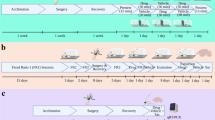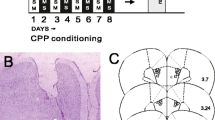Abstract
Rationale
The neuropeptide pituitary adenylyl cyclase-activating peptide (PACAP) and its receptors (PAC1 and VPAC2) are expressed in the ventral tegmental area and nucleus accumbens, raising the possibility that PACAP could be a potential modulator of the mesolimbic dopaminergic system.
Objective
The present study was designed to determine if PACAP plays a role in acute motor stimulatory and rewarding actions of morphine.
Methods
The effect of intracerebroventricular PACAP administration (0, 0.03, 0.3, 1.0, or 3.0 μg/3 μL) was studied on basal motor activity as well as on morphine (5 mg/kg)-stimulated motor activity. Motor stimulation and conditioned place preference (CPP) induced by morphine (5 or 10 mg/kg) were also determined in mice lacking PACAP and their wild-type controls.
Results
Intracerebroventricular PACAP dose-dependently suppressed basal motor activity and PACAP-deficient mice exhibited higher basal motor activity than control mice, providing evidence that the action of endogenous PACAP on basal motor activity is inhibitory. Paradoxically, low doses of PACAP which did not alter basal motor activity were found to enhance the motor stimulatory action of morphine. Furthermore, morphine-induced motor stimulation was blunted in PACAP-deficient mice. Additionally, morphine-induced CPP following a single, but not repeated, alternate-day saline/morphine (10 mg/kg) conditioning was blunted in PACAP-deficient mice compared to their wild-type littermates/controls.
Conclusion
The present results suggest that endogenous PACAP, at low doses, positively modulates the acute motor stimulatory and rewarding actions of morphine.



Similar content being viewed by others
References
Bardo MT, Bevins RA (2000) Conditioned place preference: what does it add to our preclinical understanding of drug reward? Psychopharmacology (Berl) 153:31–43
Colwell CS, Michel S, Itri J, Rodriguez W, Tam J, Lelievre V, Hu Z, Waschek JA (2004) Selective deficits in the circadian light response in mice lacking PACAP. Am J Physiol Regul Integr Comp Physiol 287:R1194–R1201
Di Chiara G, Imperato A (1988) Drugs abused by humans preferentially increase synaptic dopamine concentrations in the mesolimbic system of freely moving rats. Proc Natl Acad Sci USA 85:5274–5278
Fibiger HC, Phillips AG (1988) Mesocorticolimbic dopamine systems and reward. Ann N Y Acad Sci 537:206–215
Franklin KBJ, Paxinos G (1997) The mouse brain in stereotaxic coordinates. Academic Press, Inc., San Diego, California, USA
Ghatei MA, Takahashi K, Suzuki Y, Gardiner J, Jones PM, Bloom SR (1993) Distribution, molecular characterization of pituitary adenylate cyclase-activating polypeptide and its precursor encoding messenger RNA in human and rat tissues. J Endocrinol 136:159–166
Harmar AJ, Sheward WJ, Morrison CF, Waser B, Gugger M, Reubi JC (2004) Distribution of the VPAC2 receptor in peripheral tissues of the mouse. Endocrinology 145:1203–1210
Hashimoto H, Nogi H, Mori K, Ohishi H, Shigemoto R, Yamamoto K, Matsuda T, Mizuno N, Nagata S, Baba A (1996) Distribution of the mRNA for a pituitary adenylate cyclase-activating polypeptide receptor in the rat brain: an in situ hybridization study. J Comp Neurol 371:567–577
Hashimoto H, Shintani N, Tanaka K, Mori W, Hirose M, Matsuda T, Sakaue M, Miyazaki J, Niwa H, Tashiro F, Yamamoto K, Koga K, Tomimoto S, Kunugi A, Suetake S, Baba A (2001) Altered psychomotor behaviors in mice lacking pituitary adenylate cyclase-activating polypeptide (PACAP). Proc Natl Acad Sci USA 98:13355–13360
Johnson SW, North RA (1992) Opioids excite dopamine neurons by hyperpolarization of local interneurons. J Neurosci 12:483–488
Koob GF, Swerdlow NR (1988) The functional output of the mesolimbic dopamine system. Ann N Y Acad Sci 537:216–227
Lutfy K, Do T, Maidment NT (2001) Orphanin FQ/nociceptin attenuates motor stimulation and changes in nucleus accumbens extracellular dopamine induced by cocaine in rats. Psychopharmacology (Berl) 154:1–7
Marinelli M, Aouizerate B, Barrot M, Le MM, Piazza PV (1998) Dopamine-dependent responses to morphine depend on glucocorticoid receptors. Proc Natl Acad Sci USA 95:7742–7747
Marquez P, Baliram R, Gajawada N, Friedman TC, Lutfy K (2006) Differential involvement of enkephalins in analgesic tolerance, locomotor sensitization, and conditioned place preference induced by morphine. Behav Neurosci 120:10–15
Marquez P, Baliram R, Kieffer BL, Lutfy K (2007) The mu opioid receptor is involved in buprenorphine-induced locomotor stimulation and conditioned place preference. Neuropharmacology 52:1336–1341
Marquez P, Baliram R, Dabaja I, Gajawada N, Lutfy K (2008) The role of beta-endorphin in the acute motor stimulatory and rewarding actions of cocaine in mice. Psychopharmacology (Berl) 197:443–448
Masuo Y, Ohtaki T, Masuda Y, Tsuda M, Fujino M (1992) Binding sites for pituitary adenylate cyclase activating polypeptide (PACAP): comparison with vasoactive intestinal polypeptide (VIP) binding site localization in rat brain sections. Brain Res 575:113–123
Moore MS, DeZazzo J, Luk AY, Tully T, Singh CM, Heberlein U (1998) Ethanol intoxication in Drosophila: genetic and pharmacological evidence for regulation by the cAMP signaling pathway. Cell 93:997–1007
Moser A, Scholz J, Gansle A (1999) Pituitary adenylate cyclase-activating polypeptide (PACAP-27) enhances tyrosine hydroxylase activity in the nucleus accumbens of the rat. Neuropeptides 33:492–497
Nussdorfer GG, Malendowicz LK (1998) Role of VIP, PACAP, and related peptides in the regulation of the hypothalamo–pituitary–adrenal axis. Peptides 19:1443–1467
Ogawa T, Nakamachi T, Ohtaki H, Hashimoto H, Ndummyra S, Baba A, Watanabe J, Kikuyama S, Shioda S (2005) Monoaminergic neuronal development is not affected in PACAP-gene-deficient mice. Regul Pept 126:103–108
Otto C, Martin M, Wolfer DP, Lipp HP, Maldonado R, Schutz G (2001) Altered emotional behavior in PACAP-type-I-receptor-deficient mice. Brain Res Mol Brain Res 92:78–84
Palkovits M, Somogyvari-Vigh A, Arimura A (1995) Concentrations of pituitary adenylate cyclase activating polypeptide (PACAP) in human brain nuclei. Brain Res 699:116–120
Sheward WJ, Lutz EM, Harmar AJ (1996) Expression of pituitary adenylate cyclase activating polypeptide receptors in the early mouse embryo as assessed by reverse transcription polymerase chain reaction and in situ hybridisation. Neurosci Lett 216:45–48
Sheward WJ, Lutz EM, Copp AJ, Harmar AJ (1998) Expression of PACAP, and PACAP type 1 (PAC1) receptor mRNA during development of the mouse embryo. Brain Res Dev Brain Res 109:245–253
Thiele TE, Willis B, Stadler J, Reynolds JG, Bernstein IL, McKnight GS (2000) High ethanol consumption and low sensitivity to ethanol-induced sedation in protein kinase A-mutant mice. J Neurosci 20:RC75
Vaudry D, Gonzalez BJ, Basille M, Yon L, Fournier A, Vaudry H (2000) Pituitary adenylate cyclase-activating polypeptide and its receptors: from structure to functions. Pharmacol Rev 52:269–324
Waschek JA, Casillas RA, Nguyen TB, Cicco-Bloom EM, Carpenter EM, Rodriguez WI (1998) Neural tube expression of pituitary adenylate cyclase-activating peptide (PACAP) and receptor: potential role in patterning and neurogenesis. Proc Natl Acad Sci USA 95:9602–9607
Wise RA (1989) Opiate reward: sites and substrates. Neurosci Biobehav Rev 13:129–133
Yoburn BC, Lutfy K, Azimuddin S, Sierra V (1990) Differentiation of spinal and supraspinal opioid receptors by morphine tolerance. Life Sci 46:343–350
Acknowledgements
The authors wish to thank Mr. Rishi Talwar for technical assistance. This work was supported in part by the State of California funds for medical research on alcohol and substance abuse through the University of California, San Francisco and in part by National Institutes of Health grants HD06576, HD34475, and HD0461 and (J.A.W.), DA05010 (C.J.E.), DA016682, and an intramural grant at Western University of Health Sciences (K.L.)
Author information
Authors and Affiliations
Corresponding author
Rights and permissions
About this article
Cite this article
Marquez, P., Bebawy, D., Lelièvre, V. et al. The role of endogenous PACAP in motor stimulation and conditioned place preference induced by morphine in mice. Psychopharmacology 204, 457–463 (2009). https://doi.org/10.1007/s00213-009-1476-9
Received:
Accepted:
Published:
Issue Date:
DOI: https://doi.org/10.1007/s00213-009-1476-9




